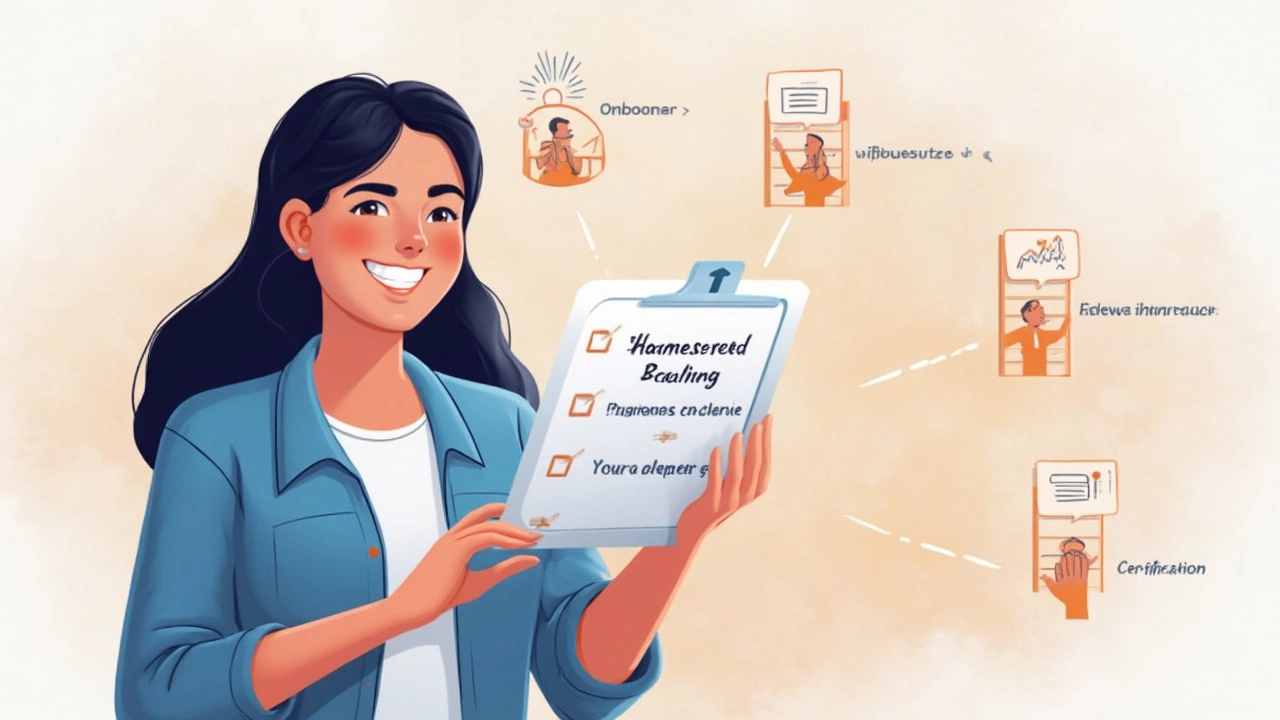Picture this: your friend sends you a link to an online course on a random website. Is that truly an eLearning platform, or just a regular site with a couple of videos? A lot of people get mixed up here. It's easy to think any website with learning content is an eLearning platform, but that's not how it works.
The real deal gives you more than just content. You get stuff like progress tracking, interactive quizzes, and maybe even a certificate at the end. If it’s missing those core features, you’re probably not on a real eLearning platform. Think of it like this: just because a park has a ball doesn’t make it a soccer field. There are standards.
Stick with me. I’m going to break down exactly what to look for, call out the fakes, and show you how to pick the right spot for your online learning. Whether you’re out to learn Python or brush up on your baking, knowing the difference matters. Let’s make sure you don’t waste time—or money—on a knockoff.
- What Counts as an eLearning Platform?
- Key Features to Look For
- Popular Examples vs. Pretenders
- How to Choose the Right One for You
- Common Traps to Avoid
What Counts as an eLearning Platform?
Not every website offering videos or downloadable PDFs is an actual eLearning platform. The difference comes down to what you can do as a learner. On a real eLearning platform, you don’t just read or watch—you can interact, ask questions, track your progress, and even get feedback. It’s all about the whole learning experience being seamless and organized in one place.
The best eLearning platforms usually give you:
- User accounts—so you have your own learning space
- Modules or full courses you can follow at your own pace
- Quizzes or assignments to see how you’re doing
- Progress tracking—like a dashboard or checklist
- Certificates or badges when you finish something
- Community spaces, maybe forums or group chats to connect with others
Take a look at big names like Coursera, Udemy, or Khan Academy. They all have these core features. A random blog post or YouTube playlist doesn’t cut it because there’s no structure or way to see your progress. Even some university websites only posting lecture slides aren’t true platforms—they’re more like online libraries.
Want numbers? In 2024, over 85% of surveyed students said they prefer eLearning platforms that offer interactive quizzes and certificates over those that just provide reading material. That’s a big hint: people expect platforms to do more than just deliver info—they want the full learning package.
So, the real eLearning platforms bring everything to one place, letting you learn, practice, check your skills, and sometimes even connect with other learners along the way. If you can do all this, you’re on the right kind of site.
Key Features to Look For
If you want to spot a legit eLearning platform, you can’t just go by looks or flashy banners. Real eLearning platforms pack in certain features that make learning online easy, organized, and effective. Here’s what you should look for before wasting hours on a dud.
- Course Structure and Navigation: Good platforms organize content into clear modules, lessons, or sections. You should be able to find your spot fast, not scroll endlessly through random videos.
- Progress Tracking: This is a biggie. Real platforms remember how far you’ve gotten, save your progress, and often show what you’ve finished versus what’s left. No more guessing.
- Interactive Elements: Look for quizzes, polls, discussion forums, or assignments. If you’re just pressing play and watching, it’s not true e-learning. Interaction keeps you engaged and helps info stick.
- Assessments and Feedback: You should be able to test yourself as you go. Many platforms offer graded quizzes, peer reviews, or instructor feedback.
- Certificates or Badges: Some people learn for the fun, some for proof. If you want proof, look for platforms giving certificates or digital badges after you complete a course or exam. Big names like Coursera and LinkedIn Learning offer these.
- Mobile Compatibility: Learning on the go is a must for most people in 2025. Any serious eLearning site works well on your phone or tablet, not just a laptop.
Check out this quick comparison to see how popular eLearning platforms stack up on key features:
| Platform | Progress Tracking | Quizzes | Certificates | Mobile App |
|---|---|---|---|---|
| Udemy | ✔️ | ✔️ | ✔️ (paid courses) | ✔️ |
| Khan Academy | ✔️ | ✔️ | ❌ | ✔️ |
| YouTube | ❌ | ❌ | ❌ | ✔️ |
| Coursera | ✔️ | ✔️ | ✔️ | ✔️ |
One last tip—pay attention to support options. The best platforms have help desks, FAQs, or direct support. If you ever get stuck, you’ll get answers, not frustration. Avoid any site that looks like it’s from 2002 and never responds.

Popular Examples vs. Pretenders
When you start searching for an eLearning platform, you’ll see a bunch of names pop up. Some are legit. Some aren’t. Here’s how to tell what actually counts.
First, real eLearning platforms are designed from the ground up for online learning. Think Coursera, Udemy, and Khan Academy. These sites let you sign up, track your progress, access tons of courses, take quizzes, and sometimes earn official certificates. If you’ve ever used Duolingo to practice a new language, that’s another classic example. You get reminders, fun achievements, and a clear learning path.
On the other hand, beware of sites that just toss up a few YouTube playlists or PDFs and call it a day. Sure, you might learn something, but they aren’t true eLearning platforms. There’s no user account, no record of what you’ve done, and no interactive stuff.
- Real eLearning Platforms: Coursera, Udemy, Khan Academy, LinkedIn Learning, Skillshare
- Pretenders: Personal blogs, static web pages listing resources, open Google Drive folders with random files
Some companies even try to look like an online learning platform by creating slick landing pages but not giving basics like quizzes or certifications. If it looks like a directory of links or a video dump, don’t confuse it with platforms that actually help you learn and grow.
Quick stat: According to Class Central, Coursera alone had over 100 million registered learners by early 2024. That’s huge—and it’s because they do more than toss up content. They manage the full learning experience and offer value that just isn’t there with the pretenders.
You want a site with:
- Structured courses
- Progress tracking
- Interactive tests or quizzes
- Some way to earn proof of completion
Spotting the real thing saves you headaches. Next time you land on a site, check for these features before you trust it with your time—or your wallet.
How to Choose the Right One for You
With so many eLearning platforms floating around, it’s pretty easy to feel lost. Before you sign up, think about what you actually want from the platform. Are you hoping for a ton of different courses, something really focused, or maybe a place that’ll give you a certificate you can actually use at work? There’s no one-size-fits-all answer. Here’s a simple guide to picking right:
- Check the course catalog. If you want lots of choices, platforms like Coursera and Udemy stack up thousands of options in everything from coding to baking cookies. If you prefer depth over variety, try something more niche—like Codecademy for coding or MasterClass for creative skills.
- Look for real instructors. Quality matters. Stick with platforms where you can check out the teachers’ backgrounds. LinkedIn Learning lists instructor bios, which helps you figure out if you’re learning from someone who knows their stuff.
- Think about interactivity. Just watching videos? Or can you join discussions, take quizzes, or submit projects? Platforms like edX and Khan Academy shine here with exercises and forums so learning doesn’t feel so lonely.
- Is there a certificate? Some online learning places give you a badge or certificate at the end. Coursera, edX, and LinkedIn Learning certificates can sometimes boost your resume, especially for tech roles. Be sure to see if employers recognize them in your field.
- Price check. Some platforms are totally free (hello, Khan Academy), while others charge by the month or by course. Watch for trial periods—many platforms give you a week or more to try them out before paying.
Here’s a quick look at how some popular platforms stack up on major features:
| Platform | Number of Courses | Certificate | Monthly Cost |
|---|---|---|---|
| Udemy | 210,000+ | Yes, per course | Pay per course |
| Coursera | 5,800+ | Yes | About $39+ |
| Khan Academy | Varies | No | Free |
| LinkedIn Learning | 20,000+ | Yes | About $40 |
Don’t forget to read honest reviews before you put your money down. People on Reddit or actual user forums will tell you what it’s really like. It’s kind of like picking a gym membership—you want perks you’ll use and an environment where you’ll stick with it. Check the refund policy too, just in case things don’t pan out the way you hope.
Bottom line? Pick the education technology that matches your style and what you want to get out of learning. A great eLearning platform should make things easier, not harder.

Common Traps to Avoid
If you’re on the hunt for a legit eLearning platform, it’s way too easy to get sidetracked by stuff that looks shiny but doesn’t deliver. Some sites try to sell themselves as education goldmines, but they’re missing the basics you need for real online learning.
One trap is all sizzle, no steak—pretty websites with zero real learning tools. For example, a site that just lists videos without quizzes, progress bars, or interactive assignments isn’t the same as a true online learning platform like Udemy, Coursera, or Khan Academy. If you can’t track what you’ve done or test yourself, you’re not getting the full experience.
Another big one is fake certificates. Some sketchy sites promise amazing certificates after you "finish" a course, but employers and actual schools often ignore these. Real eLearning platforms usually partner with universities or offer certificates you can show off on LinkedIn—watch for the difference.
- Hidden costs: You think you’re paying for a full course, but then you hit a wall—suddenly, there’s a fee to unlock the final exam or get your certificate. The top eLearning platforms lay out all costs before you start, clear as day.
- Barebones support: Ever needed help and just got a dead-end FAQ page or, worse, radio silence? Trusted eLearning sites offer live chat, email support, or a big community forum. Lack of support is a red flag.
- Shady privacy policies: If the site doesn’t clearly explain how your data is handled, or asks for way more info than needed, that’s a hard pass.
One eye-opening stat: a 2023 survey found that 62% of users dropped out halfway on platforms that offered no effort tracking or useful feedback. That’s almost two out of three people giving up because the platform didn’t help them move forward. That alone shows why all the extras—progress trackers, reminders, useful feedback—can make or break your learning journey.
The easiest way to sidestep these traps? Choose eLearning platforms that are well-known, have real reviews, and show all features before you sign up. If it seems too good to be true or insanely cheap for "expert-led" learning, trust your gut. Milo, my dog, will sniff out a fake tennis ball in a pile—use that same instinct when you pick your next course site.



